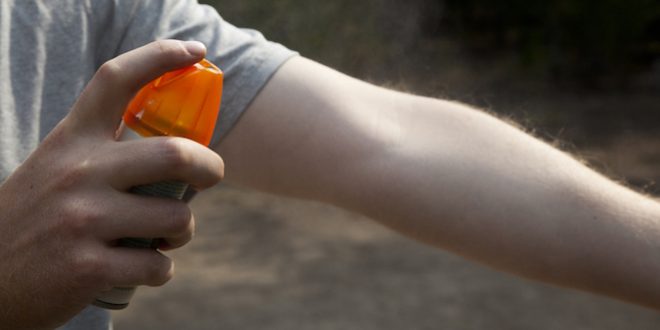For people with diabetes, there are many benefits for staying active. When activities are done often and as part of daily living, improved blood sugar levels, blood pressure targets and cholesterol levels, healthier body weight and an enhanced feeling of wellness are some of the fruits of labour. Summer is a great time to start activities outdoors or enjoy them with family and friends.
Protection against insects while outdoors can help reduce discomfort and ranges from skin irritation to severe allergic reactions to disease transmission through insect bites.
The following 3 strategies when used, alone or in combination, are effective to prevent insect bites and stings.
- Avoidance—ensure residences are insect-proof, stay indoors when insects are most likely to be active such as dawn and dusk, avoid travelling to areas during known seasons of high disease-carrying insect populations.
- Physical barriers—tips on clothing and mosquito nets
Wear long clothes: Wear long-sleeved shirts, full length pants and closed shoes if you are outdoors when mosquitoes are active or where ticks might be found.
Tuck in clothes: If you are in an area where ticks might be found, you should also tuck your shirt into your pants and pull socks up over your pant legs. This will help keep ticks away from your bare skin.
Wear light colours: Light-coloured clothing will help reduce your overall attractiveness to mosquitoes and allow you to see ticks more easily.
- Chemical barriers— personal insect repellents
Insect repellents may work by masking the signals that enable mosquitoes to locate warm-blooded victims such as humans as a source of blood meals. The two most important signals appear to be carbon dioxide and lactic acid. At close range, skin warmth and moisture, as well as volatile compounds from sweat glands, may also attract biting arthropods.
How to choose a personal insect repellent?
Use only personal insect repellents that have a Pest Control Product registration number and are labelled as insect repellents for use on humans. Never use a product labelled as an insecticide on your body.
Choose a product that meets your needs. For example, if you plan to be outdoors for a short period of time, choose a product with a lower concentration of repellent and re-apply only if you need a longer protection time.
| Recommended use of active ingredients in personal insect repellents | |||||
| Ingredient | Adult | Pediatric use | Use in pregnancy or breast-feeding | ||
| DEET (Diethyl-meta-toluamide (DEET) |
Up to 30% DEET One application of 30% DEET provides protection for 6 hours against mosquitoes |
2-12 years of age: up to 10% DEET, applied 1 to 3 times daily 6 months up to 2 years: up to 10% DEET, one application daily Younger than 6 months: not recommended No extra precaution recommended |
No data | ||
| PMD (P-menthane 3.8-diol) |
Provides up to 2 hours of protection against mosquitoes and up to 5 hours of protection against black flies. Apply up to twice daily | Younger than 3 years of age: not recommended | No data | ||
| Soybean oil (Blocker™) | A 2% blocker provides protection for 3 ½ hours against mosquitoes and for up to 8 hours against black flies. No limitation on frequency of use | No age restriction | No restriction | ||
| Icaridin | 20% in pump spray or personal towelettes provides 7 hours against mosquitoes, 8 hours against ticks 10% in aerosol provides 5 hours against mosquitoes and 7 hours against ticks |
Younger than 6 months: not recommended | No data | ||
| Citronella oil | Lacks safety data Not recommended | ||||
How to use insect repellents safely
- Apply repellents only to exposed skin or clothing as directed on the product label. Do not use under clothing.
- Never apply a repellent to cuts, wounds, or irritated skin.
- Do not apply to the eyes and mouth, and apply sparingly around the ears. When using sprays, do not spray directly into your face. Spray on your hand first, and then apply to your face.
- Do not allow your child to handle the product, and don't apply the repellent to your child's hands. When using a repellent on your child, apply it to your hands and then put it on the child.
- Do not spray in enclosed areas, such as inside a car. Avoid breathing a repellent spray, and do not use it near food.
- Use just enough repellent to cover exposed skin or clothing. Heavy application and saturation generally isn't necessary for effectiveness. If biting insects don't respond to a thin film, apply a bit more.
- After returning indoors, wash treated skin with soap and water and then bathe. This is particularly important when repellents are used repeatedly in a day or several days in a row. Also, wash treated clothing before you wear it again.
- If you think you or your child may be having a reaction to an insect repellent, stop using the repellent, wash treated skin, and call your doctor or local poison control centre. If you see your doctor, take the repellent with you.
- Sunscreen and insect repellents can be used safely at the same time. To properly apply the product, follow the instructions on the package. Apply the sunscreen first and then the insect repellent.
- Products combining skin moisturizer and insect repellent are NOT approved for use by Health Canada. Use separate products simultaneously when needed.
I look forward to receiving your comment in the Medication section of our Community Forums.
 Diabetes Care Community Learn, connect and care
Diabetes Care Community Learn, connect and care





